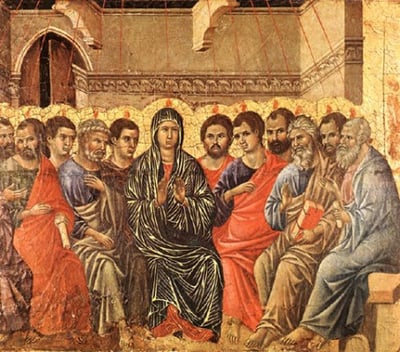 The Church, born at Pentecost, soon experienced serious growing pains. On that marvelous birthday when fired-up apostles preached in many languages, there was a very diverse crowd. But these people, though of different nationalities, were all of the same religion – they were Jews who’d come to Jerusalem for the Jewish feast of Pentecost. It wasn’t long, however, before Gentiles began joining up, especially in Antioch, the missionary base of Paul and Barnabas. This raised a serious question. Wasn’t it necessary for them to be circumcised as well as baptized? And shouldn’t they start keeping all 613 laws of Moses? Paul said no. Others thought otherwise.
The Church, born at Pentecost, soon experienced serious growing pains. On that marvelous birthday when fired-up apostles preached in many languages, there was a very diverse crowd. But these people, though of different nationalities, were all of the same religion – they were Jews who’d come to Jerusalem for the Jewish feast of Pentecost. It wasn’t long, however, before Gentiles began joining up, especially in Antioch, the missionary base of Paul and Barnabas. This raised a serious question. Wasn’t it necessary for them to be circumcised as well as baptized? And shouldn’t they start keeping all 613 laws of Moses? Paul said no. Others thought otherwise.
To settle the question, the apostles decided that the only thing to do was to gather together in Jerusalem to discuss the matter. At this meeting, occurring nearly 20 years after the Lord’s resurrection and recounted in Acts 15, a decision was reached after much debate: Gentile Christians were not to be required to live like Jews. From the perspective of the apostles and elders, this was not just some majority opinion won by those more adept at political maneuvering. Rather, it was truly a consensus crafted by the Holy Spirit (see Acts 15:28).
The language of the early Church was Greek. The Greek word for meeting or assembly is synodos or, in English, Synod. Acts 15, then, preserves the record of the first Synod in the history of the Church. A century later, when a serious heresy threatened the Church in what is now Turkey, the bishops from that region decided to meet together in a synod to decide what to do about it. From then on, it became a very normal part of Church life for neighboring bishops to meet together, listen to the Spirit through each other, and come to decisions on a variety of things: the liturgy, morality, and clarifying Catholic doctrine. In the parts of the empire where Greek remained the language, these meetings were called synods. Since the Latin translation of Synod was Concilium, these meetings came to be known in the Latin-speaking West as councils. When a heresy denying Jesus’ divinity threatened the foundations of Catholic faith all over the world, a world-wide or ecumenical council was called which gave us the Nicene Creed we say each Sunday.
One of the great themes of the Second Vatican Council, the great ecumenical synod of the twentieth century, was that the bishops of the Catholic Church are successors of the apostles, who formed a sort of college or council with Peter as their leader and spokesman. The apostles together as a unitary body witnessed to the resurrection of Christ and proclaimed the good news of salvation. So today, the bishops need to find new ways to consult with each other more regularly and speak together with one voice. So, after that council, a mechanism of episcopal collegiality was set up whereby a representative body of bishops from around the world would meet with the Pope and discuss an important issue in the life of the Church every three years. After the conclusion of this meeting, having listened to the advice of his brother bishops, the successor of Peter would write a document summing it all up. For example, Pope Francis’ apostolic exhortation on The Joy of the Gospel was written to sum up the October 2012 Synod of Bishops on the New Evangelization.
The semi-annual meetings of the National Council of Catholic Bishops in the US and in other nations are not technically called “synods.” Nevertheless, they are another expression of the apostolic collegiality of bishops whose responsibility is never limited to just their own diocese but always extends to the wider church, and can never be exercised except in union with their brother bishops.
Copyright 2014 Marcellino D'Ambrosio, Ph.D.
About the Author
Marcellino D'Ambrosio, Ph.D.
Marcellino D’Ambrosio (aka Dr. Italy) is a New York Times best-selling author, Catholic speaker, pilgrimage leader, and theology professor. Connect with him at dritaly.com or @DrItaly.


.png?width=1806&height=731&name=CatholicMom_hcfm_logo1_pos_871c_2728c%20(002).png)
Comments